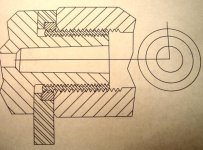In all the discussions of thread pitch I don't see anything about diameters? What is the O.D. of the tenon that goes into the bushing? Can anyone do a stess analysis on a smaller tenon?
I started a new thread so this wouldn't get lost. Don
Hi Don, nice to hear from you.

When working with an action with 1.063 X 18 tpi threads, it gets a little crowded in the front receiver ring. So far, I have made three prototypes each time reducing the tenon diameter. The first one started off at .900 before threading and I used 28 tpi. Of course, this made the bushing thickness pretty thin but it shoots great and in spite of full case loads of H4198 in my 6 Beggs with 68 grain bullets the threads torque up tight and do not loosen after firing many rounds. You can put the thickness in the tenon or the adjustable bushing. It probably does not matter because it all adds up to the same dia., anyway.
My second prototype used a .875 tenon with 28 tpi. This made the bushing a little thicker. It also shot and worked fine. I made a third prototype today with the smallest tenon yet at .800 threaded 24 tpi. Just looking at it, the tenon looks pretty small but the bushing is much thicker. I don't know which installation is stronger. Any way you look at it there is still basically the same amount of steel around the chamber so it probably does not matter.
Admittedly, I have some concern about the reduced wall thickness of the chamber. My greatest concern is for safety. I hope Jerry Stiller will do a structural analysis for me.
Except for a rimfire, I don't think it would be practical or safe to use this system with an action that has front receiver ring threads smaller than 1.0630. The only actions I have worked with so far are the Viper and Cobra drop ports. I don't know how it's going to work with a coned breach like the Panda's.
With your OmniTurn you can program it to turn out parts with miminum clearance. If you decide to try it, I would suggest using a tenon diameter of .875 threaded 24 tpi with minimum clearance. Make the bushing .875 in length and cut two 5/32 keyway slots in the rear of the bushing. Old barrel stubs work great.
You can make a screwdriver type tool to go in from the rear of the action and engage the two slots. I drilled the tool shaft with a #3 drill to accept a 5/32 x one inch sqare key securing it with a small set screw. I had to grind on the key a little to get it to fit the slots. With this tool, you can snug up the bushing with the barrel in place and then tighten to full torque with a barrel vise and action wrench.
Keep in touch. Hope this makes sense.
Later,
Gene Beggs


